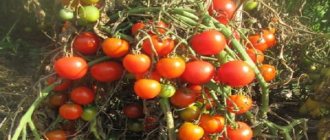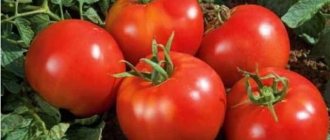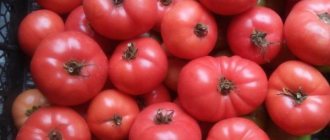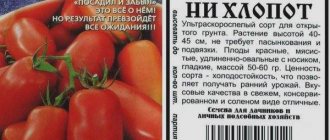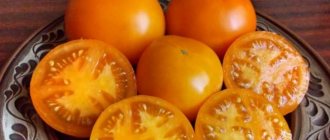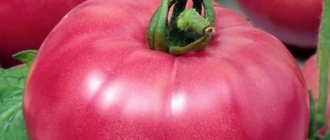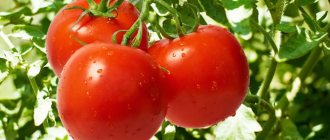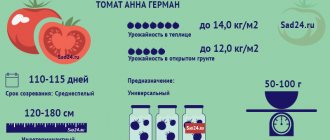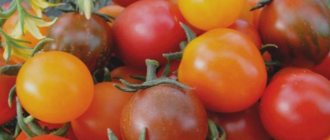Vegetable growing » Tomatoes
0
1179
Article rating
Kira Stoletova
In the spring, most people go out to their garden plots and plant seedlings or crop seeds. Their main task is to grow vegetables not only for consumption raw, but also for canning for the winter. For this reason, breeders have developed a special type of tomatoes suitable specifically for canning. This species was the Pickling Miracle tomato.
Description of the tomato Pickling Miracle
Description and characteristics of the variety
The Pickling Miracle tomato is included in the State Register as a crop bred for cultivation in private plots, cottages and farms. It can be grown in regions with a wide variety of climates, as it is resistant to abnormal temperatures, including prolonged heat or cold.
Characteristics and description of the Salting Miracle variety includes an idea of the appearance of the plants. These are low (up to 50 cm), compact bushes with a rigid, erect stem. Their growth has a certain limit (determinant variety). It stops with the formation of the last, apical inflorescence.
A neat crown makes it possible to plant beds with high density - 5-7 bushes can be freely placed on one square meter. The advantage of Pickling Miracle tomatoes is also their rapid ripening. The harvest can be harvested within 3 months after sowing.
The fruits have all the characteristics of pickled tomatoes. They are small (weight does not exceed 90 grams) and have a rich, bright red color.
The very first ripened tomatoes are larger than the fruits that ripen later. Their pulp has a characteristic dense consistency. The skin is thin, but durable, and is not susceptible to cracking from exposure to hot water.
Such tomatoes are suitable for transportation and long-term storage. Both fresh and canned, they have a classic tomato taste. Many users claim that salted and pickled tomatoes are more delicious than fresh ones.
Growing seedlings
Healthy, strong seedlings are the key to a rich harvest. It is not difficult to grow it yourself. You need to decide on the amount of planting material, and then go to the store to buy seeds. Be sure to make sure that the seeds have not expired - it is indicated on the bag. Expired seeds may not sprout or will sprout only rarely. There you can also buy small boxes and suitable soil, peat tablets or cups, everything is equally suitable.
A week after sowing, your seedlings will germinate. If you sowed the seeds in boxes, the distance between the plants is small, and as they grow, they need to be pruned, but not before real leaves appear.
Store-bought soil mixture can be used for sowing without tillage. You can prepare the soil for seedlings yourself in the fall and store it in a barn or cellar. Before sowing, it must be treated against pests and fungi. Very hot water with a small amount of potassium permanganate (the color of the solution is pink) is suitable for this. It is more convenient to spill the soil directly in the boxes before sowing. Tomatoes need to be sown 2.5 months before harvest. Sowing too early will lead to overgrowth of the seedlings, which complicates the survival rate when planting.
You can grow seedlings at home, in a warm greenhouse with sowing in mid-March (in the middle zone) and in a greenhouse without natural heating with sowing in mid-April.
Timing of sowing seeds
One of the main characteristics of Pickling Miracle tomatoes is their unpretentiousness when growing.
The timing of sowing seeds and the specifics of caring for seedlings are regulated depending on the prevailing climatic conditions in the region and the planting location. In most areas, tomatoes are grown in open ground. But where significant drops in air temperature are possible (Siberia, the Urals, the Far East), the greenhouse method is more often practiced.
Sowing of seeds is carried out 2 months before planting the grown seedlings in the ground. It is important to carefully calculate the timing of sowing. Planting seeds into the soil too early can lead to seedlings overgrowing and worsening their survival rate.
Dates for sowing and planting tomatoes Pickling Miracle in open ground:
- In the southern regions, seeds are sown in February, and seedlings are planted in the ground in late March - early April.
- In central Russia, the sowing time is early April; planting in a permanent place is carried out in May.
- In areas of risky farming, sowing occurs at the end of April - beginning of May, and planting in the ground is carried out in June.
It is important that when planting seedlings, the soil is warmed to 18 degrees Celsius.
If tomatoes are planted in protected soil, the timing may differ slightly (depending on the type of greenhouse):
- When growing tomatoes at home or in greenhouses with a heating system, seedlings are sown for seeds in mid-March;
- When planting in cold greenhouses, sowing time is mid-April.
The greenhouse option for determinate-type crops is less preferable than growing in open ground. There their growth is significantly limited, which means lower yields. Therefore, another method is used to plant the variety. Tomatoes can be planted in open ground using a portable film cover. The method combines several advantages: tomatoes will be planted in open beds, and, at the same time, reliably protected from late frosts. In this case, you can expect higher yields than when grown in stationary greenhouses.
Main types of tomatoes
Depending on their growth, tomatoes are divided into several types:
- standard,
- indeterminate,
- semi-determinate,
- determinant.
Let's take a closer look at each variety.
Standard
These are the shortest tomatoes, distinguished by their compact bush size and thick stem. Standard varieties are not the most productive varieties; their main advantage is their early ripening.
The main advantages of the type include:
- resistance to adverse factors - drought, frost;
- thick stem, thanks to which the plant does well without tying;
- tight fit due to compact size;
- shallow roots, allowing active absorption of water and additional nutrients;
- good transportability of fruits.
Standard crops are grown mainly in greenhouses and greenhouses; it is advisable to plant them in open ground only in the southern regions.
Standard varieties include the following varieties:
- Cameo is an early-ripening variety with smooth fruits, juicy pulp and a pleasant aroma.
- Buyan - the average weight of cylindrical fruits is 90 g. Excellent for preservation, resistant to the vagaries of weather, tobacco mosaic.
- Yamal is characterized by increased resistance to diseases and pests. With proper care, you get a good harvest of dense, rounded fruits weighing 70-100 g.
Indeterminate
The stem of indeterminate tomatoes reaches 2-4 m in height, so varieties must be tied up. To limit the plant's growth, pinch the top of the stem. This variety is characterized by long-term fruiting; in heated greenhouses, the plant bears fruit throughout the year.
Advantages:
- high yield - 14-17 kg/m²;
- stable immunity to fungal diseases and the vagaries of nature.
The disadvantages include the mandatory strict adherence to the rules of agricultural technology, especially when forming a plant bush.
Among the many indeterminate crops there are:
- Angel F1 is a new domestic hybrid without restrictions on the region of cultivation, early ripening, for salad purposes. It is characterized by high productivity, good immunity to fusarium and verticillium.
- Belfast F1 is a popular early-ripening hybrid, immune to cladosporiosis, fusarium, tobacco mosaic, and tolerates transportation well. The fruits weigh an average of 210 g, do not crack, and the yield is high - up to 26 kg/m².
Tomato Angel F1
Other indeterminate varieties and hybrids are Walford's Miracle, Crushed Heart, Tyler f1, Lion's Heart, Star of Siberia.
Semi-determinant
Semi-determinate plants stop growing at about 10-12 inflorescences, are characterized by high productivity, do not require complex care, and are suitable for greenhouses and open ground.
A distinctive feature of the species is short internodes.
Among the many semi-determinate varieties are:
- Magnus is an early variety with tasty fruits and is considered ideal for canning.
- Silhouette is a greenhouse hybrid; its small fruits are perfectly stored and transported.
- Red Arrow is one of the most unpretentious varieties, suitable for canning and summer salads, and is characterized by high yield.
- Zinulya is a mid-season variety with large and sweet fruits.
Tomato Magnus
Determinant
Determinate tomatoes are varieties that stop growing when a cluster of flowers appears at the top. The height does not exceed 80 cm. They are grown everywhere: in the southern regions - in open ground, in other parts of Russia - in hotbeds and greenhouses.
Such plants bear fruit once per season for 1-3 weeks.
The main advantages of determinate tomatoes:
- precocity;
- high productivity;
- friendly return;
- low maintenance requirements;
- possibility of cultivation even in northern regions;
- suitability for canning.
The disadvantages are quite controversial - some vegetable growers consider determinate tomatoes less tasty.
The best varieties of determinate tomatoes:
- Alsou is a mid-early, large-fruited variety. Grown in open and closed ground, yield up to 9 kg/m². Used fresh and in salads.
- Gina TST is a mid-season variety that does not require pinching for film greenhouses and open ground. Resistant to cracking and disease, suitable for canning and fresh consumption.
- Lyubasha F1 is an ultra-early hybrid of universal use, resistant to cracking and disease, suitable for growing in open and closed ground. It has a high yield - up to 20 kg/m².
Tomato Alsou
Features of cultivation and care
Standard varieties of tomatoes, which include the Salting Miracle, have a powerful, erect stem and a compact crown. Such varieties do not require shaping or tying. During fruiting, the plants quietly lean to one side, freeing up the space necessary for care and harvesting.
As necessary, pinching is carried out (elimination of side shoots). The highest quality harvest is obtained from single-stem bushes, on which 5 large clusters are left (10-12 peduncles each).
Plant care is simple and consists of regular watering with warm water (2-3 times a week), proper soil fertilization, and prevention of diseases and pest attacks.
Watering should be a uniform irrigation of the soil. This method will cause the foliage to dry out. As a result, the plant will direct all its energies to the development and ripening of fruits.
Experienced vegetable growers use green manure to improve the growth of tomatoes. Mustard is considered one of the best. Additionally, the plant serves as a natural fertilizer for tomatoes. Mustard retains moisture in the soil, suppresses the growth of weeds, loosens the soil, enriches it with microelements, and protects tomatoes from pests (wireworms, slugs, mole crickets). In addition, it can be used as mulch by breaking up and covering the surface of the soil.
For good growth, Pickling Miracle tomatoes require fertilizing based on phosphorus and potassium.
The number of ovaries is increased by spraying the plantings with a solution of boric acid. Foliar irrigation is carried out twice: when the first cluster blooms and at the beginning of the fruiting period.
Planting seedlings and soil
Properly grown seedlings are the key to a good future harvest. Tomatoes need to be regularly fed, watered and the light regime of the day observed. During the first period of growing seedlings, preparations with a high nitrogen content are used as fertilizing. The seedlings are picked at the moment two or three true leaves appear and the tomatoes are directly transplanted into soil enriched with potassium and phosphorus. Thanks to chemical elements, tomatoes quickly adapt to a new environment and take root well.
The living conditions for tomatoes in open soil are characterized by unstable temperature changes, which can have a detrimental effect on young leaves of seedlings. To avoid this situation, plants must first be hardened off. This is done gradually. At the initial stage, seedlings are hardened by ventilating the room, then the plants are taken out to the balcony for 15-20 minutes. Thanks to this technique, tomato leaves gradually begin to get used to the scorching rays of the sun and fluctuating temperatures.
Resistance to diseases and pests
The Salting Miracle variety is resistant to diseases and pest attacks. It has natural protection, since the leaves contain alkaloids that are poisonous to insects. Tomatoes practically do not suffer from late blight, fusarium, and anthracnose.
When attacks by the Colorado potato beetle, manual collection of pests is used. Treatment with insecticides is allowed only before the fruiting period. It is not recommended to use chemicals for prevention in the absence of signs of disease.
Advantages and disadvantages
Pickling miracle tomatoes are popular among gardeners. They note that this variety fully lives up to its name: the fruits retain their taste with any method of preservation and can be subjected to long-term storage and transportation.
The main advantages of the variety are strong immunity, high yield, ease of cultivation and care.
Advantages of the cultivar:
- There is no need to form bushes.
- The selection and preparation of seed material can be carried out independently, and there is no risk of loss of varietal qualities.
- If it is not possible to wait for the fruits on the branch to ripen, ripening occurs at home.
- The crop does not require frequent watering and loosening.
Among the disadvantages, gardeners note: abundant watering and frequent rains worsen the taste of the fruit. In this case, the tomatoes become watery.
Similar varieties
The Pickling Miracle tomato is similar in characteristics and descriptions to the following varieties:
- Watercolor;
- Triumph;
- Newbie.
Tomato Watercolor is a mid-early variety that can be grown in open ground or in a greenhouse. It is determinate, the height of the bushes rarely exceeds 50 cm. The crown is significantly branched. The variety is characterized by high productivity; up to 8 kg of tomatoes are harvested per square meter.
The fruits are bright red, yellowish at the base, elongated in the shape of cream, and have a thick skin. Thanks to their dense, sugary pulp and durable shell, they are well suited for pickling. Fruiting begins 4 months after sowing the seeds. Plants are resistant to diseases and pests.
Determinate tomato variety Triumph grows better in open ground. Suitable for cultivation in various climatic conditions, it is drought-resistant. The bushes have a straight stem up to 80 cm high. The plant needs a garter only during the fruiting period to support the branches bending under the weight of tomatoes.
The variety is early ripening. The first harvest is harvested 100 days after planting. Tomatoes are rich pink in color, medium in size, weighing about 70 grams, in a form convenient for canning.
Tomatoes Novichok are a determinate variety, suitable for industrial and private breeding. A popular cultivar, valued for its reliability and stable yields. The stem is not rigid, reaches a height of 85 cm. Among the disadvantages is the need for regular pinching and gartering of bushes.
Medium early variety. The fruits are scarlet, have the shape of cream, weigh up to 120 grams, have a thick skin and fleshy, sweetish pulp. Ideal for canning, but delicious fresh straight from the bush. The culture is characterized by uniform yield. Resistant to diseases and pests.
Tomato Pickling miracle
Early, racemose, determinate variety of tomatoes for open ground, film shelters and greenhouses.
The bush is compact, 50-80 cm high, does not require pinching. Some gardeners still remove the shoots before the first flower cluster in order to get an earlier harvest. However, this slightly reduces the yield.
Basic qualities of fruits
The fruits are oval cream, smooth, even, dense, red in color at maturity, weighing 90-100 grams, juicy, good taste. Not prone to cracking, transportable. These tomatoes are ideal for whole-fruit canning, but are also suitable for fresh consumption and processing into tomato products.
The variety is resistant to late blight and other tomato diseases.
The advantages of Pickling Miracle tomatoes also include high yield, good transportability and good keeping quality of the fruit.
This tomato variety is not included in the state register of breeding achievements in the Russian Federation.
Features of cultivation
Sowing the seeds of this variety of tomatoes for seedlings is carried out 55-60 days before the intended planting in the ground. Dive - at the stage of appearance of the second true leaf. When planting seedlings in a permanent place per 1 sq. m area it is recommended to place up to 6 plants. Planting pattern: 70 x 30 - 40 cm.
All further care for tomatoes consists of timely watering, weed removal, fertilizing and preventive measures to protect plants from diseases and pests.
Tomato Pickling miracle on video
If you grew Pickling Miracle tomatoes, please write what the yield and taste of the fruit was like in your climatic conditions. How do you rate the disease resistance of this variety? If possible, attach a photo of the entire bush or individual fruits you grew.
Your reviews of the Pickling Miracle tomato, as well as additions to the description, will help many gardeners evaluate this variety more objectively and decide whether it is worth planting or not.
